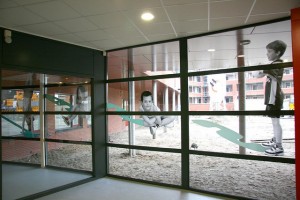Printed glass in interior design
One consideration when decorating with glass is balancing the need for openness with the need (or desire) for privacy. Whether you’re decorating in a commercial space or a residential one, the need for privacy is absolute at certain times. In short, clear glass isn’t always desirable. At the same time, painted glass may not be what you’re going for, either.
One excellent compromise is printed glass. Printed glass has been used for a long time in commercial spaces, for both interior and exterior options.
Initially, a silkscreening process was used to create “printed” glass. Silk screening uses a screen mesh to apply ink to the print surface. Areas of the mesh are blocked selectively to create different shapes or to apply multiple colors.
Screen printing has been around for more than a thousand years, and can be used with inks and paints. The technique can apply color to both hard and soft surfaces, including glass.
Silkscreen printing has its limitations, though. Consumers and retailers alike prefer photorealistic images, which silkscreen printing isn’t really good at creating. Photorealistic printing is better achieved with UV-inkjet techniques that deposit colored inks onto the surface of the glass.
UV-inkjet printing doesn’t require any special heat or chemical curing process, which makes it less expensive than other forms of glass printing. In addition, UV inkjet printing is highly durable, a plus in a commercial environment. UV inkjet printing allows commercial consumers to reproduce colorfast branding and logo information on glass inexpensively and without the pixilated look of silkscreen printing.
UV inkjet printing isn’t just reserved for commercial environments. In residential spaces, UV inkjet printing can quickly and inexpensively produce patterned glass surfaces for use in bathrooms, kitchens and throughout a home. Glassprimer™ glass surface molecular activator can help ensure that printed inks bond with the glass to improve durability and performance.
If you’d like more information about how you can use Glassprimer™ glass surface molecular activator in a glass printing project, please visit the rest of our site. If you’d like to purchase Glassprimer™ glass surface molecular activator or Glassprimer™ glass paint, please visit our online store .
Photo Credit: Rob Borgman, via Flickr.com



